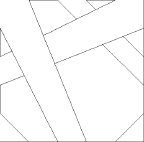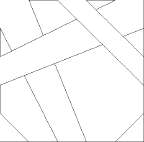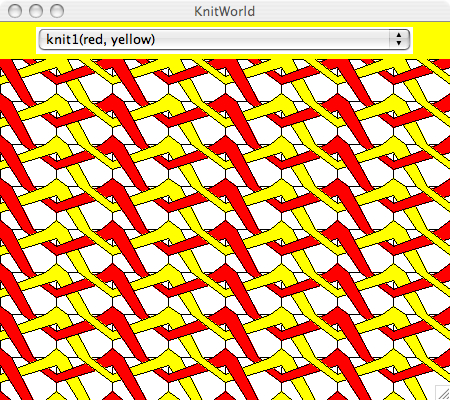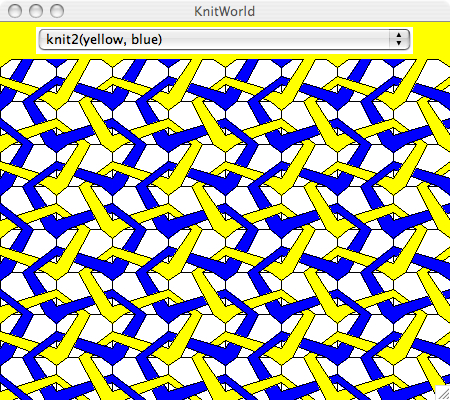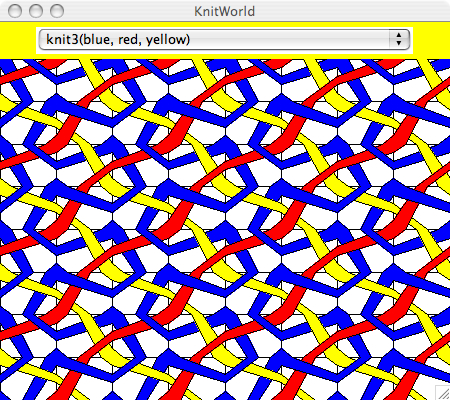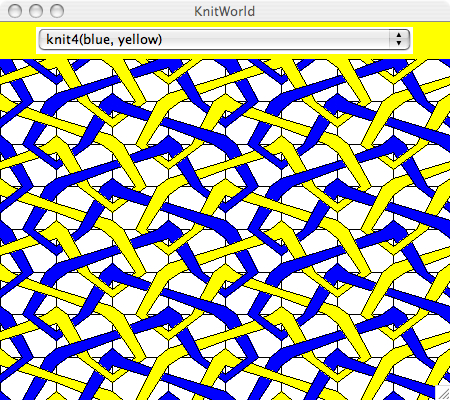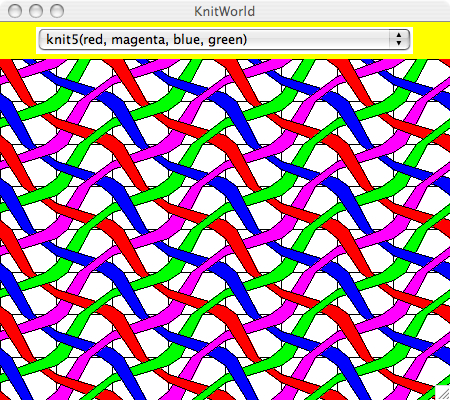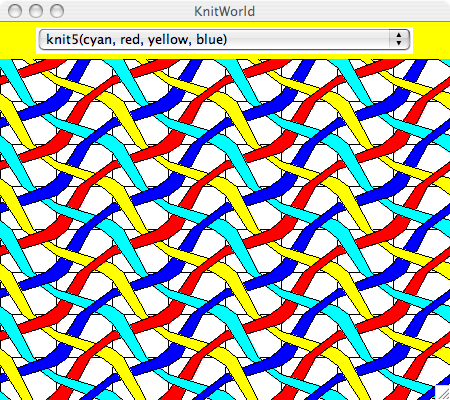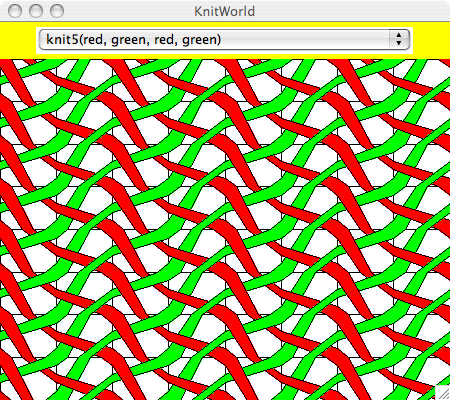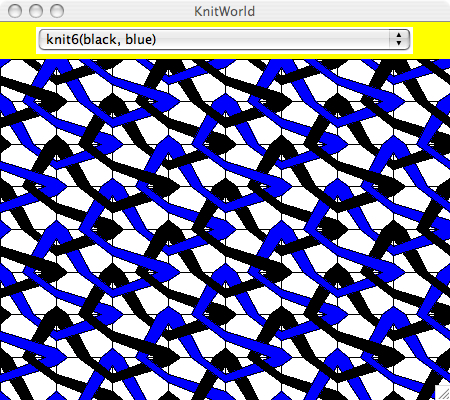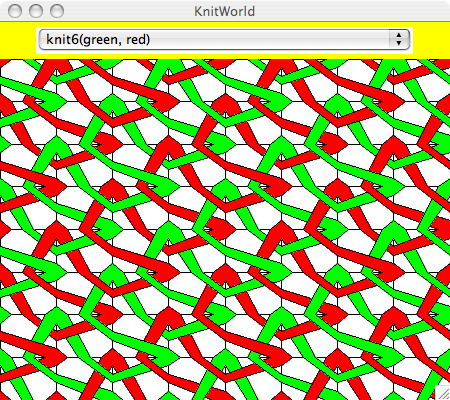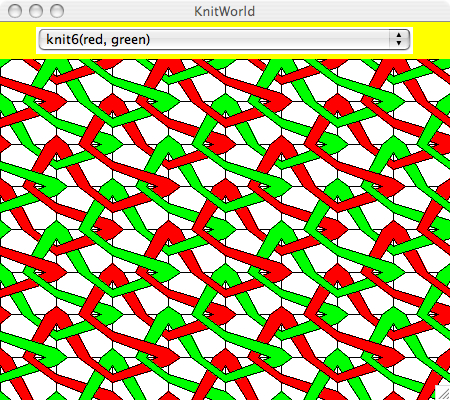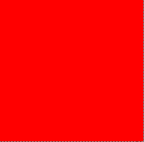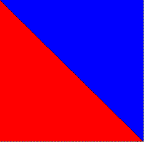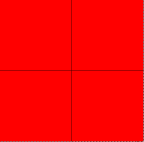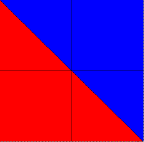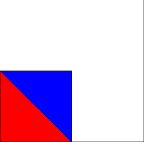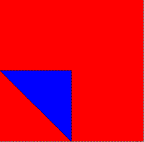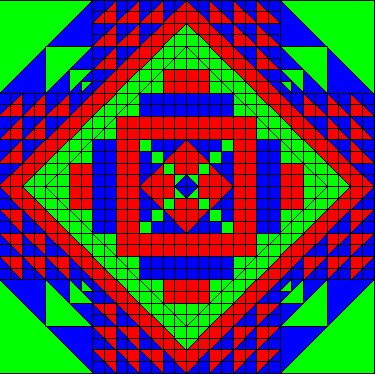Due Date
Because of the President's Day holiday on Monday Feb. 20, this assignment will be due on Fri, Feb. 24 at 5pm rather than on Tuesday, Feb. 21. This week drop-in hours will be on Wednesday and Thursday nights; there will be no Sunday or Monday night drop-ins this week.
Reading
Review the slides from the Introduction to PictureWorld and Divide/Conquer/Glue in Picture World lectures and the problems from Lab 4. Additionally, study these contracts:About this Problem Set
In this problem set, you will practice reading, writing, and understanding fruitful methods. Task 1 exercises your understanding of fruitful PictureWorld methods through invocation trees. In Tasks 2 and 3, think carefully about what patterns should be abstracted into methods and which patterns should be named as variables. In Task 4, you will write a Java application from scratch with class methods for calculating your CS111 course grade.
Task 1 (Invocation Tree) and Task 3 (QuiltWorld) are tasks on which you are *required* to work in pairs. On these two tasks (but not the others) you must work with a partner. You may choose a different partner from previous psets or choose one you have worked with before.
To get the code for this assignment, connect to the cs server via
Fetch or WinSCP. Use the cs111d account and the password given
in class and download the ps04_programs folder.
How to turn in this Problem Set
You must turn in both a hardcopy and a softcopy. For general guidelines on problem set submission, including how to submit a softcopy and how to check if you softcopy submission was successful, click here. Please make sure to keep a copy of your work, either on an external storage device (like a USB drive), or in your private directory (or, to play it safe, both).
Hardcopy Submission
Your hardcopy packet should consist of:
- The cover page;
- Your Object Land and Invocation Tree drawing from Task 1 (Only one member of a team should submit this drawing. The other member should indicate on their cover sheet that their partner submitted it. The drawing itself should list the names of both team members.);
- Your modified
KnitWorld.javafile from Task 2; - Your modified
QuiltWorld.javafile from Task 3. (Only one member of a team should submit this file. The other member should indicate on their cover sheet that their partner submitted it. The top comment on the file should list the names of both team members.) - Your
Grades.javafile from Task 4.
Staple these together, and submit the packet by 5pm on the due date.
Softcopy Submission
Save the modified KnitWorld.java and
QuiltWorld.java files in the ps04_programs
folder. Also, save your Grades.java file in
the ps04_programs folder. Submit the entire
ps04_programs folder to your
drop folder on the CS111 server.
(Only the team member who submitted the hardcopy of QuiltWorld.java
need submit the softcopy.)
PictureWorld Examples
To demonstrate some of the capabilities of PictureWorld, we have
included the file MyPictureWorld.java in the
ps04_programs folder you downloaded. You can
compile the file and run the program if you are interested. This file
has lots of examples of Picture manipulations. You are not required
to do anything with this file for the assignment. We have included it
only because it demonstrates lots of Picture examples. Most of the
examples are commented out so that the menu of the applet is not
cluttered, but feel free to un-comment whatever examples you are
interested in experimenting with.
(This file is essentially the same as the SimplePictureWorld.java
file we studied in the first PictureWorld lecture.)
Task 1: PictureWorld Invocation Tree
This is a task on which you are *required* to work in pairs. On this task and Task 3 (but not other tasks) you must work with a partner. All work by a team must be a true collaboration in which members actively work together on all parts of the Task. It is not acceptable for team members to split up the tasks and work on parts independently.
As discussed in lecture, an invocation tree is a summary of
all the frames created in ExecutionLand within the Java Execution
Model. It contains a node for each method called during the execution
of a program (even "black-box" methods like forward and
left in BuggleWorld and clockwise90 and
above in PictureWorld). Each node contains the receiver
of the method invocation, the name of the method, the values of its
arguments, and (where applicable) its result. There is an edge
connecting each "parent" node to the "children" nodes for the method
invocations performed directly within the body of the parent. The
children nodes for a given parent are stacked vertically, arranged
from top to bottom in the order of their execution.
First Example
As a first example, consider the execution of
fourSame(leaves), where leaves
denotes the two-green-leaves pattern presented in class and
fourSame is defined as follows:
public Picture fourSame (Picture p) {
return fourPics(p, p, p, p);
}
public Picture fourPics (Picture p1, Picture p2, Picture p3, Picture p4) {
return above(beside(p1,p2), beside(p3,p4));
}
Below is a JEM for this example in which Object Land shows all the
objects created and Execution Land shows an invocation tree of all
execution frames created during the evaluation fourSame(leaves).
The object label SPW stands for the SimplePictureWorld object that receives the
method invocation and PIC1 denotes the leaves Picture object. Each
node contains the value of the receiver, followed by the method name,
followed by the argument values enclosed in parentheses. The result
of invoking the method is then shown after a colon. Note that the
nodes at the same level are drawn from top to bottom in the order
that the methods are invoked.

Second Example
As a second example of an invocation tree, consider the execution of
rotations(gw), where gw
denotes the green wedge pattern presented in class and
rotations is defined as follows:
public Picture rotations (Picture p) {
return fourPics(clockwise270(p), p, clockwise180(p), clockwise90(p));
}
As shown below, this invocation involves a PictureWorld object (SPW) seven picture objects (PIC1 through PIC7), and eight execution frames.
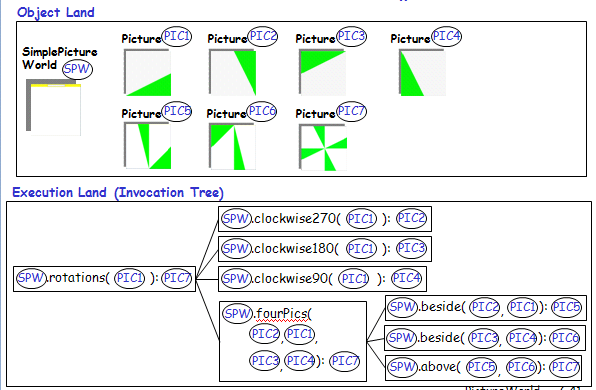
The body of rotations invokes four methods
(clockwise270, clockwise180, clockwise90,
and fourPics), so nodes for these four invocations are stacked
vertically as children of rotations. Similarly,
fourPics invokes three methods (two invocations of beside
and one of above), so nodes for these three invocations are
stacked vertically as children of fourPics.
Your Task
In this problem, you will draw both Object Land and
an invocation tree for the invocation tents(gw),
where gw is the green wedge pattern from above
and tents is a SimplePictureWorld method defined as follows:
public Picture tents (Picture p) {
return tent(tent(p));
}
public Picture tent (Picture p) {
Picture p90 = clockwise90(p);
return above(p, beside(flipHorizontally(p90), p90));
}
Your Object Land should show a SimplePictureWorld object SPW,
the Picture object for the green wedge,
and every Picture object created in the invocation
tents(gw).
To represent a Picture object, you should sketch the picture represented by
that object within a square and give it an object label enclosed in an oval
(e.g PIC1, PIC2, etc.), as in the above examples.
As in the above examples, your invocation tree should have one boxed node
for each execution frame created during the evaluation of
tents(gw), including frames for "black-box"
PictureWorld methods like clockwise90,
flipHorizontally, beside, and above.
Each boxed node should show:
- the object label for the receiver of the method, followed by a dot;
- the name of the invoked method;
- the object labels for all method arguments, delimited by parenthesis and separated by commas;
- and the object label for the result value returned by the method invocation, following a colon.
The nodes for all methods invoked directly within the body of another method should be drawn to the right of the other method and stacked vertically, from top to bottom in the order they are invoked. A line should connect a method invocation node to the nodes of each method invoked within it.
You should label the part of your drawing containing the Picture objects "Object Land" and the part that contains the invocation tree "Execution Land". You may have trouble fitting both lands on a single piece of paper, so feel free to put Object Land on one and the invocation tree on another.
Task 2: Knit Picking
Escher's Knitting Patterns
Dutch artist M. C. Escher is renowned for creating artwork based on interlocking patterns and visual playfulness. Here we will experiment with knitting patterns that Escher himself experimented with in 1943. (For more details on Escher's artwork, see M.C. Escher: Visions of Symmetry by Doris Schattschneider, W.H. Freeman and Company, 1990).
Escher's knitting patterns were based on the following two primitive patterns that he designed:
|
|
|
We will call these patterns A and B. We can make many variants of A an B by rotating them, flipping them, and painting their stripes different colors. These variants of A and B can be combined to form an amazing number of patterns that resemble the weave patterns of knitted yarn. For example, study the following four knitting patterns, all of whose basic squares are versions of A and B that have been rotated, flipped, and colored in various ways.
|
|
|
|
|
|
Playing with Knitting Patterns in PictureWorld
PictureWorld is a perfect tool for experimenting with Escher's
knitting patterns. The file KnitWorld.java
in the ps04_programs folder contains
several methods that aid in this experimentation. Colored versions of
the A and B patterns are created by the following two black-box
methods in KnitWorld.
public Picture tileKnit (Picture p1, Picture p2, Picture p3, Picture p4)
{
return fourSame(fourSame(fourPics(p1, p2, p3, p4)));
}
The fourSame() and fourPics() methods are
as presented in lecture and lab:
public Picture fourSame (Picture p)
{
return fourPics(p, p, p, p);
}
public Picture fourPics (Picture p1, Picture p2, Picture p3, Picture p4)
{
return above(beside(p1, p2), beside(p3, p4));
}
Using the above methods, plus the usual picture combinators of
PictureWorld, it is possible to make pictures for all four knitting
patterns shown above. Here is a knit1()
method, parameterized over two colors, that generates the
knit1 pattern shown above:
public Picture knit1(Color c1, Color c2)
{
Picture A1 = A(c1, c2, c1, c1, c2);
Picture B1 = B(c2, c1, c2 ,c2, c1);
return tileKnit(A1, B1, A1, B1);
}
The knit2() method is similiar in structure to
knit1(), but uses different colorings, flips, and
rotations:
public Picture knit2(Color c1, Color c2)
{
Picture A1 = A(c1, c2, c1, c2, c1);
Picture B1 = B(c2, c1, c2 ,c1, c2);
return tileKnit(flipVertically(B1),
flipVertically(A1),
clockwise180(B1),
clockwise180(A1));
}
The knit3() method is parameterized
over three colors rather than two:
public Picture knit3(Color c1, Color c2, Color c3)
{
return tileKnit(B(c1, c2, c1, c3, c1),
clockwise90(B(c1, c3, c2, c2, c1)),
flipHorizontally(B(c1, c3, c1, c2, c1)),
flipHorizontally(clockwise90(A(c1, c2, c3, c3, c1))));
}The knit4 pattern has a more complex
repetition pattern than can be described by tileKnit().
Two alternative knit4() methods are shown below. Both
methods produce identical pictures. The first uses 12 local
variables to refer to the various intermediary pictures that
are generated while constructing the final picture pattern. The
second uses only 2 local variables to refer to intermediary pictures,
instead preferring to nest expressions by having fruitful method
invocations, which return Picture objects, serve as arguments to other
methods with Picture parameters. The two alternative methods for capturing the
knit4 pattern represent two different problem solving approaches
that achieve the same result.
public Picture knit4(Color c1, Color c2)
{
Picture A1 = A(c1, c2, c1, c1, c2);
Picture B1 = B(c1, c2, c1, c2, c1);
Picture A2 = A(c2, c1, c2, c1, c2);
Picture B2 = B(c2, c1, c2, c2, c1);
Picture A1_clockwise270 = clockwise270(A1);
Picture A1_flipDiagonally = flipDiagonally(A1);
Picture B1_flipHorizontally = flipHorizontally(B1);
Picture B2_flipDiagonally = flipDiagonally(B2);
Picture B2_clockwise270 = clockwise270(B2);
Picture A2_flipHorizontally = flipHorizontally(A2);
Picture tile1 = fourPics(B1, A1_clockwise270, B1_flipHorizontally, B2_flipDiagonally);
Picture tile2 = fourPics(A2, B2_clockwise270, A2_flipHorizontally, A1_flipDiagonally);
return fourSame(fourPics(tile1, tile2, tile1, tile2));
}
public Picture knit4_alternative(Color c1, Color c2)
{
Picture tile1 = fourPics(B(c1, c2, c1, c2, c1),
clockwise270(A(c1, c2, c1, c1, c2)),
flipHorizontally(B(c1, c2, c1, c2, c1)),
flipDiagonally(B(c2, c1, c2, c2, c1)));
Picture tile2 = fourPics(A(c2, c1, c2, c1, c2),
clockwise270(B(c2, c1, c2, c2, c1)),
flipHorizontally(A(c2, c1, c2, c1, c2)),
flipDiagonally(A(c1, c2, c1, c1, c2)));
return fourSame(fourPics(tile1, tile2, tile1, tile2));
}
Your Task
In this problem, you will define a method that draws the
knit5 knitting pattern.
knit5() is parameterized over four colors. The particular
knit5 patterns shown below are created by the invocation
that you can read in the top of the KnitWorld picture (in the yellow
bar at the top of the image). For example, the top left
knit5 pattern in created by this invocation:
knit5(Color.red, Color.magenta, Color.blue,
Color.green).
|
|
|
|
|
|
Add your definition of the following method to
the file KnitWorld.java:
public Picture knit5(Color c1, Color c2, Color c3, Color c4);
Be sure to uncomment the menu items for knit5() in
the initializePictureChoices() method so you can test
your code!
To begin this problem, first study the knit1()
through knit4() methods above and
convince yourself that they do in fact draw the four knitting
patterns shown in the previous section. Your solution to
knit5()
will be similar to the knit1() through
knit4(). Next, you should carefully study
the knit5
pattern to determine which rotations, flips, and colorings of the
basic patterns A and B are employed. The final step is to encode your
findings in Java in the your knit5() method.
You may find it helpful to
define your own auxiliary methods in addition to defining
knit5().
Testing your program
To make testing a little easier, we have included a folder
Test which contains working examples of the patterns you
need to make so that you can compare your work with the examples (but,
alas, no Java code!). There are two different ways to see the examples.
- Use your web browser to open the file
KnitWorldSoln.htmlin theTestfolder that you downloaded withps04_programs. You can chooseknit5andknit6from the menu to compare these examples with your own work. -
In Dr. Java, open the file CS111.txt in the
Testfolder that you downloaded withps04_programs, click on the Interactions tab at the bottom of the Dr. Java window and typejava KnitWorldSolnin the Interactions pane.
Ungraded Challenge
Do not attempt this problem until you have finished the entire problem set.Write a knit6() method that behaves as shown below.
|
|
|
|
|
|
Task 3: QuiltWorld
This is a task on which you are *required* to work in pairs. On this task and Task 1 (but not other tasks) you must work with a partner. All work by a team must be a true collaboration in which members actively work together on all parts of the Task. It is not acceptable for team members to split up the tasks and work on parts independently.
Blithe Buggle, co-founder of the Buggle Bagel Ruggle Company, has
been looking for new ways to expand her company's product line.
Although the bagel rugs marketed by the company are popular, they are
difficult to manufacture because of the labor costs (each rug is
hand-drawn by a Buggle) and and raw material costs (bagels cost more
than you think!). Blithe thinks the company should diversify to
produce other products with interesting designs, such as
quilts,wallpaper, and sweaters. Blithe is currently experimenting
with the picture drawing software presented in CS111 to design
quilts. Here is an example of one of Blithe's quilt designs, which we
will call quilt1.
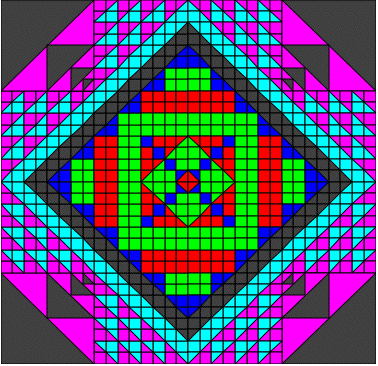
quilt1()You and several other CS111 students have been hired as interns at
the Buggle Bagel Ruggle Company to help Blithe design quilts. Your
project is to use PictureWorld to generate the quilt design shown
above. The quilt above is just one sample of the quilt design. Your
code will contain methods that take color parameters, and therefore
your code will be able to generate lots of different quilts, in the
same pattern as above, but with color variation. This description of
the assignment will use the quilt above as an example, but keep in
mind that your code must be generic and able to handle different
color variations of the above pattern. There is a file called
QuiltWorld.java in the ps04_programs folder.
All the methods that you will define for this problem will be in the
QuiltWorld class. Your goal is to flesh out the skeleton
of the quilt1() method so that it returns a picture
corresponding to the quilt shown above. This picture is ultimately
generated by combining primitive pictures generated by the following
two black-box methods:
publicPicture patch (Color c)
Returns a rectangular patch of colorcwith a black border that fills a given picture frame.
publicPicture triangles(Color c1, Color c2)
Returns a picture that consists of two triangles filling the given picture frame: a black-bordered triangle of colorc1in the lower left corner of the frame; and a black-bordered triangle of colorc2in the upper right corner of the frame.
For example, below are the pictures generated by some sample
invocations of these methods:
|
|
|
Divide, Conquer, and Glue
The key to solving the problem of defining quilt1() is to note that
the picture can be decomposed into smaller pictures that are used
more than once in the larger picture. For example, the upper right
quadrant is a picture that we'll call corner:
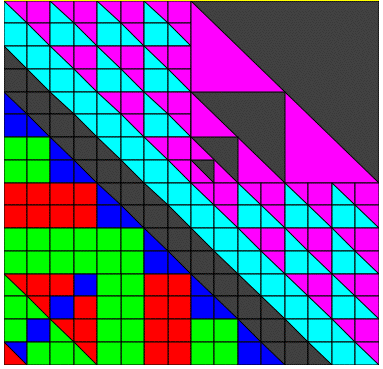
corner(Color.red, Color.blue, Color.green, Color.darkGray, Color.cyan, Color.magenta)The whole picture can be decomposed into four copies of
corner that have different rotations. Once we figure out
how to define the corner picture, we can combine four
rotated copies of the picture to form the desired quilt picture. This
is an excellent illustration of the divide, conquer, and glue
problem solving strategy we will use throughout this course:
- Divide the problem into subproblems. Here there is one
subproblem: defining
corner(). - Conquer the subproblems by solving them. In this case,
the solution to the subproblem is a picture named
corner. - Glue the solutions to the subproblems together to form
the solution to the whole problem. Here, we combine four rotated
versions of
cornerto construct ourquilt.
But how do we solve the problem of defining the corner
picture? By applying the divide, conquer, and glue strategy
again! In this case, you should decompose the corner
picture itself into four quadrants. You can define methods
quadrant1(), quadrant2(), etc. Of course,
the methods will take appropriate parameters.
Continue this way, decomposing each problem into smaller
subproblems, until you reach problems that can be solved using our
primitives (e.g., patch() and triangle()).
Auxiliary Methods
A general principle of computer science is “never write any piece of code more than once.” If you find yourself writing the same or similar code more than once in your program, you should write methods that capture the patterns of the repeated code and invoke the methods instead.
The divide, conquer, and glue process of defining
quilt1() naturally exposes the need for numerous
auxiliary methods. As part of working on this assignment, define and
use the following methods (insert the definitions under the "Auxiliary
methods" comment in QuiltWorld.java).
publicPicture patch_2x2 (Color c)
Returns a picture consisting of four rectangular patches of colorcwith black lines between the patches. (Remember thatpatch(c)returns a picture with a black border.)
publicPicture triangles_2x2 (Color c1, Color c2)
Returns a picture similar totriangles(c1, c2)except that each large triangle is composed out of three smaller fragments (two triangles and a rectangle).
publicPicture LL (Picture p)
Returns a picture which divides the picture space into four quadrants and places the given picture in the lower left corner.
publicPicture LLNest (Picture p1, Picture p2)
Returns a picture which places picturep2over the lower left corner of picturep1.
As you implement these methods, uncomment out the corresponding
items in initializePictureChoices() to test them!
Here are example invocations of the four methods above:
|
|
|
|
|
|
Completing the Assignment
All of the methods in the PictureWorld and
QuiltWorld
contracts are available to you. At a minimum, you should have methods that
correspond to each pattern shown above. In addition to that, you
should define additional methods which capture patterns that are used
over and over again. It is also helpful to define local
variables within your methods to give names to pictures that you
generate as part of your solution.
Given the patterns and auxiliary methods specified above, all the
quadrants (quadrant1(), etc.) should be very simple.
Each of your methods should be short: no more than a few statements long (say 5 or 6). If you find yourself defining a longer method, consider how you can break it up into smaller parts (preferably in a way that permits one or more of the smaller of the methods to be used multiple times).
Testing your program
To make testing a little easier, we have included a folder
Test that contains working examples of the patterns you
need to make so that you can compare your work with the examples (but,
alas, no Java code!). There are two different ways to see the examples.
- Use your web browser to open the file
QuiltWorldSoln.htmlin theTestfolder that you downloaded withps04_programs. You can choose components of your design, such ascorner,quadrant1,LLorLLNestto compare them to your work. -
In Dr. Java, open the file CS111.txt in the
Testfolder that you downloaded withps04_programs, click on the Interactions tab at the bottom of the Dr. Java window and typejava QuildWorldSolnin the Interactions pane.
Your final Task.
Oh no! Blithe has just designed this new quilt shown below, using
the same pattern as above, but with different colors. She forgot how
she actually created this one. She hires you to figure out which
Color parameters were used in what order to create the pattern below.
To solve this problem, write a new method called quilt2() that produces the quilt shown below.
quilt2()Task 4: An Application to Calculate Your CS111 Grade
Important note: Before you begin working on the fourth task, make sure to save and close all Java files from the previous task.
In this task, you will write an application, named
Grades, from scratch. The application will
calculate your final grade in CS111 based on your homework and exam scores.
Of course, you have not yet received all of your homework and exam
scores, so you are free to make up whatever scores you like for each
assignment and exam. Based on ten homework scores and three exam
scores, your application should print out (i.e., using
System.out.println) your final score (between 0.0 and
100.0) in the course and your final letter grade (e.g., C+ or A).
(Note: We usually grade your psets on a scale 0.0 to 50.0, but
the pset scores for this task should be in the range 0.0 to 100.0;
so you'll need to double your actual pset scores for this application.)
Your Grades class should contain the
following five class methods:
/**************************************************************************
Given scores (between 0.0 and 100.0) on ten problem sets,
returns the average of those ten scores.
**************************************************************************/
public static double psetAverage(double ps1, double ps2, double ps3,
double ps4, double ps5, double ps6,
double ps7, double ps8, double ps9,
double ps10)
For example, here is a test of psetAverage in the Dr. Java Interaction pane:
> Grades.psetAverage(90.0, 94.0, 100.0, 84.0, 87.0, 92.0, 100.0, 77.5, 100.0, 81.3) 90.58
/**************************************************************************
Given scores (between 0.0 and 100.0) for a problem set average and three
exams, returns a final score in the course.
* The problem sets contribute 0.40 to the final score.
* The first exam contributes 0.15 to the final score.
* The second exam contributes 0.25 to the final score.
* The final exam contributes 0.20 to the final score.
**************************************************************************/
public static double courseScore(double psetAvg, double exam1,
double exam2, double examFinal)
For example, here is a test of courseScore in the Dr. Java Interaction pane:
> Grades.courseScore(90.58, 82.0, 86.5, 91.0) 88.357
/**************************************************************************
Given a final score (between 0.0 and 100.0) in the course,
the method returns a String representing the corresponding
letter grade for the final score. A score:
>= 93.33 results in a letter grade of "A".
>= 90.00 results in a letter grade of "A-".
>= 86.67 results in a letter grade of "B+".
>= 83.33 results in a letter grade of "B".
>= 80.00 results in a letter grade of "B-".
>= 76.67 results in a letter grade of "C+".
>= 73.33 results in a letter grade of "C".
>= 70.00 results in a letter grade of "C-".
>= 60.00 results in a letter grade of "D".
< 60.00 results in a letter grade of "F".
**************************************************************************/
public static String letterGrade(double score)
For example, here is a test of letterGrade in the Dr. Java Interaction pane:
> Grades.letterGrade(88.357) "B+"
/**************************************************************************
Given scores (between 0.0 and 100.0) on ten problem sets and three exams,
displays (1) the ten pset scores, (2) the pset average, (3) the three exam
scores, (4) the course score and (5) the letter grade.
**************************************************************************/
public static void printGrades(double ps1, double ps2, double ps3,
double ps4, double ps5, double ps6,
double ps7, double ps8, double ps9,
double ps10, double exam1, double exam2,
double examFinal)
For example, here is a test of printGrades in the Dr. Java Interaction pane:
> Grades.printGrades(90.0, 94.0, 100.0, 84.0, 87.0, 92.0, 100.0, 77.5, 100.0, 81.3, 82.0, 86.5, 91.0);
Your ten pset scores are:
90.0, 94.0, 100.0, 84.0, 87.0, 92.0, 100.0, 77.5, 100.0, 81.3
Your pset average is 90.58.
Your first midterm exam score is 82.0.
Your second midterm score is 86.5.
Your final exam score is 91.0.
You earned a course score of 88.357, which results in a letter grade of B+.
/**************************************************************************
For a given collection of ten problem set scores and three exam scores
(which you choose), displays (1) the ten pset scores, (2) the pset average,
(3) the three exam scores, (4) the course score and (5) the letter grade.
**************************************************************************/
public static void main (String [] args)
The main method is tested by running the application in the
Dr. Java Interaction pane. Here is one example:
> java Grades
Your ten pset scores are:
100.0, 92.0, 89.0, 84.0, 80.0, 85.0, 91.0, 79.0, 87.0, 85.0
Your pset average is 87.2.
Your first midterm exam score is 92.0.
Your second midterm score is 80.0.
Your final exam score is 88.0.
You earned a course score of 86.28, which results in a letter grade of B.
